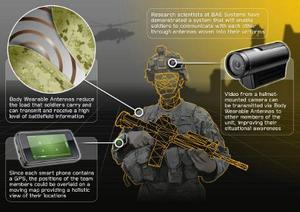First response gearBody wearable antennas for soldiers, first responders
Body Wearable Antennas (BWAs) allow soldiers to communicate with their colleagues on the front line without the need for conventional radio whip-antennas which can be cumbersome and conspicuous; NWS can also be incorporate into the suits of fire-fighters for use during search and rescue, for police patrol team members to have the GPS locations of their colleagues, and in other hazardous industries such as mining, oil, and gas

Electronic advantages of today's warfighter // Source: techeye.net
BAE Systems has developed a series of Body Wearable Antennas which will reduce the load that soldiers have to carry while providing them with battlefield information and connectivity.
The Body Wearable Antenna (BWA) allows soldiers to communicate with their colleagues on the front line without the need for conventional radio whip-antennas which can be cumbersome and conspicuous. By weaving the antennas into the fibers of the uniform, the technology allows effective communication at the same time that it improves agility. The company said a concept demonstrator has been developed to show the capability of this technology which transmits voice, video data (from a helmet-mounted camera), and GPS location via the same antenna.
The company says that a system using this technology could improve the situational awareness of a military team as a whole, allowing soldiers to see through the eyes of their team mates in real time. If one soldier spots a situation, they can alert the team and share what they can see through their helmet mounted camera. The demonstration system links with a wrist-mounted commercially available touch screen smart phone and utilizes its sensors to provide an augmented operational picture, allowing the team to tag objects, such as potential hazards which will appear highlighted on the phones video image.
Another major advantage of the wearable antenna system is that it is unaffected by the position of the wearer. With conventional whip-antenna systems, if a soldier has to lie on the ground, the communication between them and that of someone who is standing up can be compromised or even lost. Similarly, the signal from the short antenna on a portable radio can be masked by the user’s body. A BWA system can be designed to give continuous 360° coverage.
Jon Pinto, Antennas and Electromagnetics Group Leader from BAE Systems Advanced Technology Center, said: “Frontline soldiers carry a huge amount of weight when on patrol. Research into body wearable antennas has shown we could reduce this burden and in the future give forces improved communication capabilities and a significant advantage on the battlefield.”
The applications for this technology reach beyond the defense industry. BAE Systems is currently exploring the potential to incorporate body worn antennas into the suits of fire-fighters for use during search and rescue, for police patrol team members to have the GPS locations of their colleagues, and in other hazardous industries such as mining, oil, and gas.
